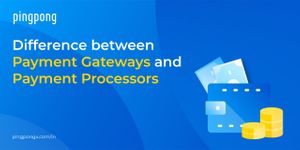
From Analog to Digital Drift
We are fast-paced homo sapiens surviving in the impatient 21st century. We lack patience and time, nowadays we don't read, we simply skim and scan through the hard or soft copy. Similarly, with the coming up of the internet, we have upgraded our bank standards from standing in tiring queues to online transactions with a click.
With technology advancements and the enriching IT sector, many of us have shifted to smart devices such as mobile, laptops, and computers. These devices not only enable us to multitask but also eases our transaction processing irrespective of borders.
Take yourself into consideration, to pay the electricity and water bill will you go to the respective offices or pay it at your convenience at your comfort? If you have the needed equipment, decent internet connectivity, and are digitally literate, you will undoubtedly opt for online payment.
Be it bill payments, online banking (domestic/international), or online shopping all these provisions are just a click away.
The Era of Rising Fintech
When the 21-days lockdown was announced the previous year, we thought it would be a temporary house arrest. Unfortunately, the reality hit hard, and work from home and lockdown became the pals of our daily lives. It was the phase when India started to adhere to the new monthly mundane rituals of the online banking process.
Did You Know?
According to the report, India observed a startling growth of 383% in digital payments from the fiscal year 2018 to 2019. Also, as per the Reserve Bank of India (RBI), the volume of digital transactions has recorded a growth rate of 58.8% during 2018-19, on top of a growth of 50.4 percent during 2017-18. It implies that the electronic payment process is in vogue.
In the booming phase of online transactions, tier-2 & 3 cities contribute over half of the online payments in 2020, says Razorpay Report.
Moreover, Razorpay believes that the digital payments sector is expected to rise by 40 to 45% in 2021 and raise the bar beyond the $5 trillion Digital India dream by 2025.
We all make online transactions smoothly and easily, but, ever wondered about the backend technicalities, how and what payment processing is used to make your transaction?
Are you aware of the payment gateway and payment processor? If not, no worries, we'll take care of your knowledge base.
What is Payment Gateway?
You might have an impressive e-commerce website providing products from A to Z, but at the time of purchase, you should offer a reliable, secure, and confidential gateway option to the consumer.
It is where payment comes into play. If a payment gateway incurs a bad experience and lacks a secure environment, people will lose their trust in your brand or offer. Therefore, a good payment gateway ensures a haven that in return brings goodwill and trust to your website or app.
A payment gateway acts as an effective third-party tool that authenticates and facilitates online transactions between the merchant's and consumer's bank. The Payment gateway plays a pivotal role in card-not-present transactions like you would have witnessed during online purchases.
PayPal, Amazon Pay, Stripe, and Skrill are a few examples of payment gateway that comply with certain safety measures to aid a secure transaction.
How does Payment Gateway Operate?
Come, let's understand the back-end chronology:
- Imagine yourself as a customer. For suppose you visited e-commerce and added the desired products to the cart. After adding the products to the cart you move to the checkout section.
- The checkout section leads you to the payment page, where you fill in your name and non-physical credit/debit card details.
- After submitting the details you are further directed to the payment gateway window that securely transmits your bank details based on the type - server-to-server, payment page integration, or client-side encryption.
- Then a secure and confidential pathway is created to transfer your card details to the acquiring bank. Then the acquiring bank that receives payment on behalf of the merchant sends the information to the respected card scheme.
- After this, the card schemes ensure a safe transaction by adding another layer of security check and then send the payment information to the issuing bank (in respect to the customer).
- After conducting the additional security check, the issuing bank authorizes the transaction. Then the message of approval or decline is reverted to the bank from the card schemes, and then to the acquiring bank.
- The merchant's acquiring bank then sends the approval or decline message to the payment gateway which then sends the message to the merchant about the status. If the transaction is successful, then the transaction happens between the issuing bank and acquiring bank.
Oh My God! a wholesome seven steps, but guess what? The whole process takes only 3-5 seconds.
What is a Payment Processor?
Both payment gateway and payment processor facilitates and authorize the payment part in the online transaction process, but they are different in their work culture.
A payment processor is a useful financial platform that enables payment between the acquiring and issuing banks. The payment processor provides a link to the gateway and merchant's account for a free and secure flow of transactions between both parties.
Therefore, a payment processor helps in facilitating the online transaction process by transmitting data between you, the merchant, issuing bank, and the acquiring bank.
Some payment processors focus on providing linear merchant service and only on authorizing payment processing. Whereas, certain payment processors also provide additional features like - card acceptance, security solutions, PCI compliance assistance, customer support, etc.
Moreover, the payment processor also guards you against fraudulent activities and checks whether the card information is correct. They also cater through incorrect additional charges over the transaction, various errors, and accidental transactions.
How does Payment Processor Operate?
- After filling the cart, the customer moves to the checkout process, where the person feeds in the card details that are then directed to the payment gateway.
- After feeding in the transaction details, the payment gateway passes the information along to the third-party payment provider the merchant uses.
- Then the payment processor transfers the transaction details to the card network, and then the respective card network will transfer the details to the customer's bank that checks for the availability of funds in the account to complete the transaction processing.
- Then the system submits the status to the card network that later highlights whether the transaction was declined or approved.
- The transaction status goes to the card network which then informs the payment processor whether the transaction should take place. The processor moves the details through to the payment gateway.
Examples of payment processors are - card issuers (the bank that issues credit/debit cards to the customer and merchant), card network (Visa, MasterCard, RuPay, Discover, Amex, etc), and Merchant acquirers (merchants merge with financial institutions to accept payment).
With the growth of online transactions (domestic/international), we have been exposed to various fraudulent ways. Which means you need to be careful which every click you make. But how to choose the right payment processor?
Don’t Google in haste because we have brought you an effective payment processor that respects your hard-earned money just like you do.
Ping Pong is a reliable payment processor that has been serving the market for six years. Undoubtedly, this is a perfect match for the ones seeking for a fool proof payment processor.
Today, Ping Pong hosts more than 600,000 e-commerce merchants worldwide with their international payments, supplier payments, VAT transactions, etc. So far Ping Pong has processed more than $10 billion for global e-commerce sellers.
Before jumping into a payment processor you should always check for these crucial requirements such as:
PCI Compliance: This is a blanket of security that ensures that the customer's information is protected. PCI compliance is a measure that almost every country demands from their retailers to make sure that the processor is safe and compliant.
Customer Service: Stuck in the middle of a transaction crisis? Or confused about how to build a smooth transaction passage? No worries because Ping Pong offers 24*7 customer service. Ping Pong will hang in with you until the problem is sorted and you aren't educated regarding the crisis.
Fraud prevention: Why have a payment processor if it can't safeguard transactions? Therefore go for a payment processor that enables confidentiality and security.
Software Compatibility: You might be using multiple softwares to run your business, but always remember that your payment processor should be in sync with the technology. It also includes the point of sale, which is the payment gateway.
Cost: Last but not the least, payment processors also cost your pocket in the form of - flat fees, transaction fees, and additional fees.
But, no worries, Ping Pong is there to your rescue because they charge very less commission rates, now don't think too much because this is inclusive of all charges.

